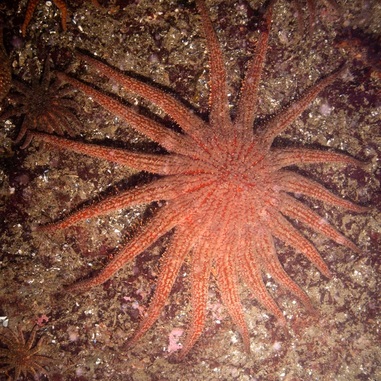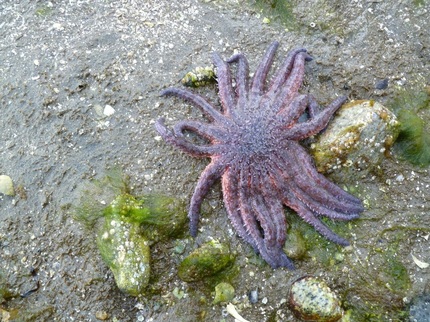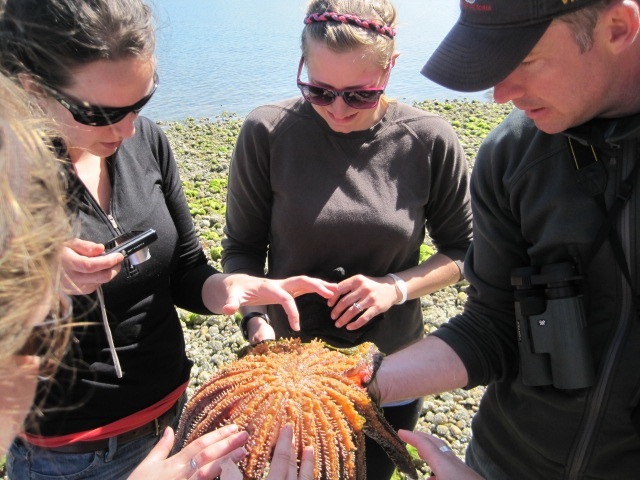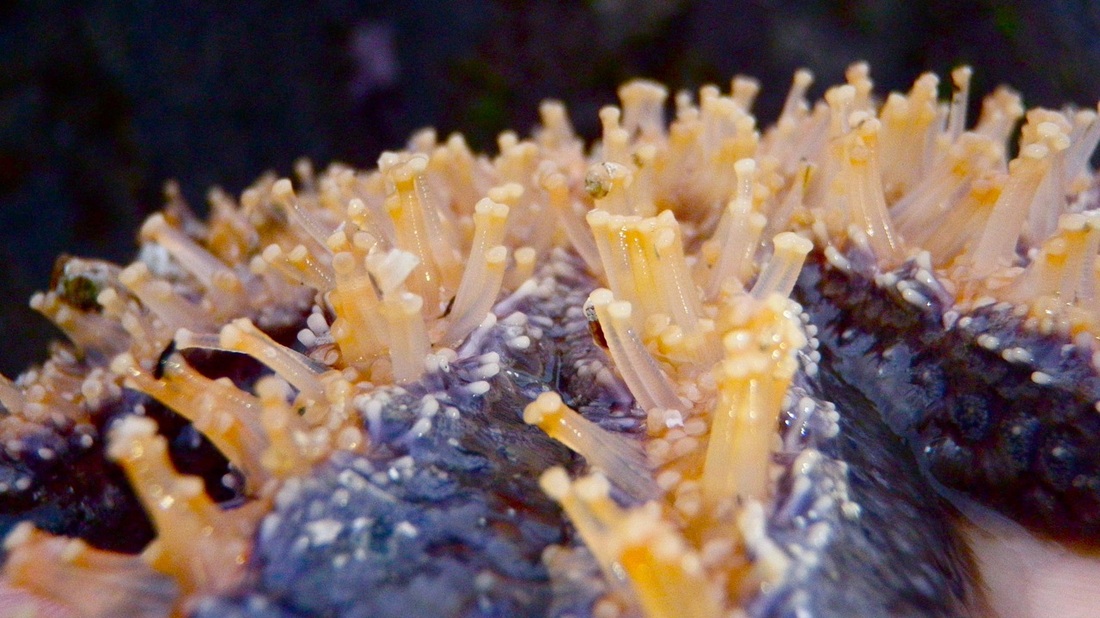Sunflower star, sunflower seastar • Pycnopodia helianthoides
Top right photo by Chanda Brietzke shows a juvenile sunflower star with 9 arms; other photos by Francine Beaujot (top left), Wiebe Nijland (bottom left), and ES 470 participants.
Identification
The sunflower star is easily recognized by its numerous long rays. It may have up to 26 rays, although juveniles typically start with 5 and grow more as they age. This species is usually orange or purple - sometimes with mottling of red-orange or purple-grey, respectively. Its upper surface is very soft and flexible. It can grow up to 1 m in diameter. Numerous orange tube feet are densely packed along the underside of its body and arms.
Habitat & Range
The sunflower star inhabits rocky surfaces and other substrates in the intertidal and subtidal, to depths of 435 m. It is found on the Pacific coast of North America from Alaska to California.
Similar Species
While there are numerous sea stars with more than 5 or 6 rays, known as 'sunstars,' no other species has as many rays or is as soft as the sunflower star. The rays are thinner, longer, and more flexible than other species as well.
The sunflower star is easily recognized by its numerous long rays. It may have up to 26 rays, although juveniles typically start with 5 and grow more as they age. This species is usually orange or purple - sometimes with mottling of red-orange or purple-grey, respectively. Its upper surface is very soft and flexible. It can grow up to 1 m in diameter. Numerous orange tube feet are densely packed along the underside of its body and arms.
Habitat & Range
The sunflower star inhabits rocky surfaces and other substrates in the intertidal and subtidal, to depths of 435 m. It is found on the Pacific coast of North America from Alaska to California.
Similar Species
While there are numerous sea stars with more than 5 or 6 rays, known as 'sunstars,' no other species has as many rays or is as soft as the sunflower star. The rays are thinner, longer, and more flexible than other species as well.
|
Intriguing Info
This is the fastest sea star in the Northern Pacific, capable of moving up to 110 m per hour. Compared to the 15cm/min, or 9 m per hour recorded speed of the leather star (Dermasterias imbricata), this is incredibly quick. Its predatory prowess has lead to multiple species developing escape responses, including the northern abalone (Haliotis kamtschatkana), swimming scallops, and the California sea cucumber (Parastichopus californicus). See this predator in action in the video at right. |
|
References
Harbo, R. M. (1999). Whelks to whales: Coastal marine life of the Pacific Northwest. Madeira Park, BC: Harbour Publishing. P. 135.
McDaniel, N. (2011). Leather star: Dermasterias imbricata. Sea Stars of the Pacific Northwest. Accessed 02/09/2013.
Pycnopodia helianthoides (Brandt 1835). Marine Biodiversity of British Columbia. Accessed 02/09/2013.
Authors and editors of page
Chanda Brietzke and Brian Starzomski (2013).
Harbo, R. M. (1999). Whelks to whales: Coastal marine life of the Pacific Northwest. Madeira Park, BC: Harbour Publishing. P. 135.
McDaniel, N. (2011). Leather star: Dermasterias imbricata. Sea Stars of the Pacific Northwest. Accessed 02/09/2013.
Pycnopodia helianthoides (Brandt 1835). Marine Biodiversity of British Columbia. Accessed 02/09/2013.
Authors and editors of page
Chanda Brietzke and Brian Starzomski (2013).









